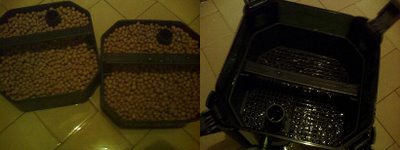Specific Gravity
 This is a hydrometer and its a hydrometer with a really suggestive name - Deep Six. What's it used for? It used to measure the specific gravity or salinity of the aquarium's water.
This is a hydrometer and its a hydrometer with a really suggestive name - Deep Six. What's it used for? It used to measure the specific gravity or salinity of the aquarium's water.Specific gravity of a liquid is a unitless measurement that indicates the density of that particular liquid with reference to another (usually pure water) The density of water is taken to be 0.001kg/1cm^3 that's what we learnt in secondary school that 1 litre of water has a mass of 1kg. Specific gravity of the aquarium's water is calculated by (density of the aquarium's water) / (density of pure water).
In this instance, a hydrometer saves us the trouble of needing to measure exactly 1 litre of aquarium water and then weighing its mass and calculating its density before finally deriving its specific gravity. The hydrometer invovles a free suspended 'pointer/indicator' which when submerged in water will start to float. Based on the principle of displacement, the denser the water the higher the 'pointer' would float. In the case of the aquarium, the more amount of dissolved salt there is in the water, the greater the reading. The less amount of dissolved salt, the lower the reading. From the pictures you can see that when the hydrometer is out of the water, the pointer is just resting down. When water pours into the hydrometer, the 'pointer rises' and when the entire device is finally submerged, the 'pointer' will float and come to a rest point which indicates the specific gravity reading. The specific gravity of sea water ranges from 1.020 to 1.023. So if the reading is too low, I'd need to dose more marine salt. If its too high, I'd need to dilute the aquarium's water with more water. Also in a closed environment such as that of the tank, as water evaporates, salt remains in the aquarium and so the specific gravity will rise. An aquarist has to be aware of that and top up the tanks water from time to time.












